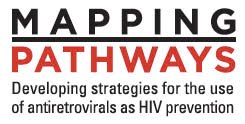Original content from the Mapping Pathways blog team
Even in the dynamic world of HIV
prevention, July 2012 is already a landmark month – even before nearly 25,000
people descend on Washington, DC for the International
AIDS Conference (AIDS 2012).
The news that has most advocates and
program implementers excited is the U.S. Food and Drug Administration
(FDA) approval of a new prevention indication for Truvada, an ARV drug
commonly used for HIV treatment. Truvada can now officially be used
as PrEP (pre-exposure prophylaxis) for people at high risk of acquiring HIV
through sexual activity. These “at-risk” individuals include HIV-uninfected gay
men and other men who have sex with men (MSM) and HIV-uninfected partners in
seriodiscordant relationships.
In approving Truvada for
PrEP, the FDA followed the recommendation of a panel of
experts that voted to approve the drug on May 10.
Here is
what the new Truvada label and prescribing information will look like.
The FDA directed drug maker,
Gilead Sciences, to come up with a Risk Evaluation and Mitigation Strategy (REMS)
to minimize the risk to uninfected individuals of acquiring HIV infection and
to reduce the risk of resistance.
Some concerns remain, the most crucial of
them being cost. Truvada is not a cheap drug – costing as high as $13,000 a
year retail in the United States (it is available as a generic for a fraction
of this cost outside the U.S.) – and it will be a challenge to get the drug to
the most “at risk” groups, many of whom lack access to any healthcare. Adherence
support, behavioral counseling, and regular HIV testing and monitoring for
potential drug toxicities will also be very important. It is clear that PrEP
needs to be embedded in a holistic healthcare construct – and it’s much more
than individuals simply taking a pill every day.
Addressing these issues (and others) are
paramount, and will occupy the energies of advocates, researchers and community
organisers, many of whom will convene and share findings at AIDS 2012.
AIDS 2012, the “granddaddy of all conferences,” according
to Jim Pickett, Director of Prevention Advocacy and Gay Men’s Health at
the AIDS
Foundation of Chicago, is a great opportunity for the Mapping
Pathways project to disseminate information and findings.
The Mapping Pathways team will be participating in a
number of sessions at AIDS 2012 starting with a satellite session on Sunday,
July 22 titled “From Revolution to Reality: How Will New Science Impact the
U.S. National HIV/AIDS Strategy?” Molly Morgan Jones from RAND Europe, a Mapping Pathways partner
organisation, will be one of the presenters in this session and will share
analyses specific to PrEP in the U.S. context. .
Jones, along with other Mapping Pathways team members, will also be
presenting two new posters at AIDS 2012, which will include information
gathered from the community surveys, policy interviews, the literature review
and the ExpertLens.
Presentation slides and posters will be featured on the blog during the
conference.
Stay tuned to the blog as we continue to bring you updates from AIDS
2012 as well as reactions from advocates and stakeholders on the FDA approval
of Truvada.
[Content that is linked from other sources is for informational purposes and should not construe a Mapping Pathways position. Please look for us on Facebook here www.facebook.com/MappingPathways and you can follow us on Twitter @mappingpathways as well.]


No comments:
Post a Comment